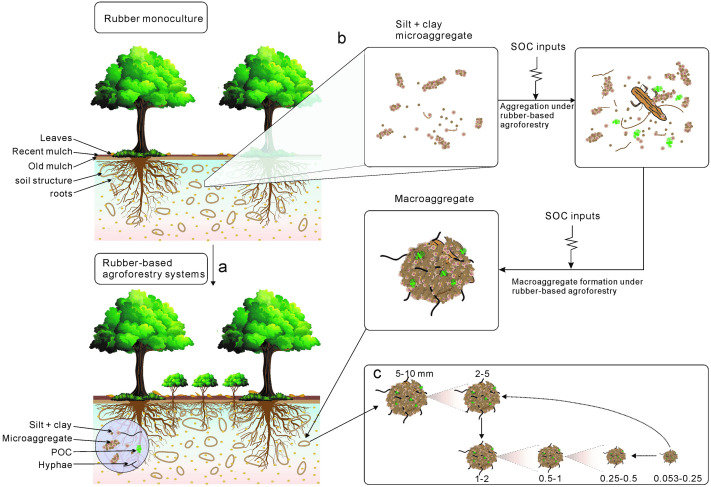A combined planting pattern of rubber and interplanting or a rubber-based agroforestry (Hevea brasiliensis) system have been considered as important ways to promote the sustainable development of agriculture and the environment. However, few studies have examined soil organic carbon (SOC) and the impacts on soil aggregates under different rubber-based agroforestry systems.
Prof. LIU Wenjie and his team of Xishuangbanna Tropical Botanical Garden (XTBG) conducted a study to evaluate the influence of rubber-based agroforestry system management on soil. They examined water stable soil aggregates (WSA), the distribution of soil organic carbon (SOC) and nitrogen (N) within the aggregates and soil carbon and nitrogen accumulation in the soils between rubber monoculture and rubber-based agroforestry systems in Xishuangbanna.
The researchers compared the differences in water stable aggregates, soil carbon, soil nitrogen and aggregate-associated carbon and nitrogen concentrations among rubber monoculture and four rubber-based agroforestry systems (H. brasiliensis–C. arabica, H. brasiliensis–T. cacao, H. brasiliensis–F. macrophylla and H. brasiliensis–D. cochinchinensis).
In their study, agroforestry practices of more than 10 years have significantly improved the quality of soil from rubber monoculture and particularly increased soil aggregation, enhanced soil carbon and nitrogen accumulation and improved SOC and N distribution within the aggregates.
The agroforestry ecosystem of H. brasiliensis–T. cacao (TCAs) improved the soil physical-chemical properties the best and had the highest continuity degree, followed by H. brasiliensis–D. cochinchinensis(DCAs), H. brasiliensis–F. macrophylla(FMAs), and H. brasiliensis–C. Arabica (CAAs).
SOC and N contents in all water-stable aggregate fractions were significantly higher in rubber-based agroforestry systems (except CAAs) compared to rubber monoculture.
The macroaggregate fraction (> 0.25 mm, especially in the 1–0.25 mm fraction) contained more organic SOC and N than the microaggregate did.
The study showed that the aggregate could physically protect SOC and N from degradation and the rubber-based agroforestry systems had a greater potential for C and N sequestration compared with the adjacent rubber monoculture sites.
The researchers recommend that the local government would prefer T. cacao, F. macrophylla and D. cochinchinensis and not C. arabica as the alternative tree species interplanted within rubber plantations in Xihsuangbanna.
The study entitled “Effects of rubber-based agroforestry systems on soil aggregation and associated soil organic carbon: Implications for land use” has been published online in Geoderma.
Contact
LIU Wenjie Ph.D Principal Investigator
Key Laboratory of Tropical Forest Ecology, Xishuangbanna Tropical Botanical Garden, Chinese Academy of Sciences, Mengla, Yunnan 666303, China
E-mail: lwj@xtbg.org.cn

Schematic diagram illustrating the effect of rubber-based agroforestry on soil aggregation and organic carbon (SOC) dynamics.
(Image by CHEN Chunfeng)

